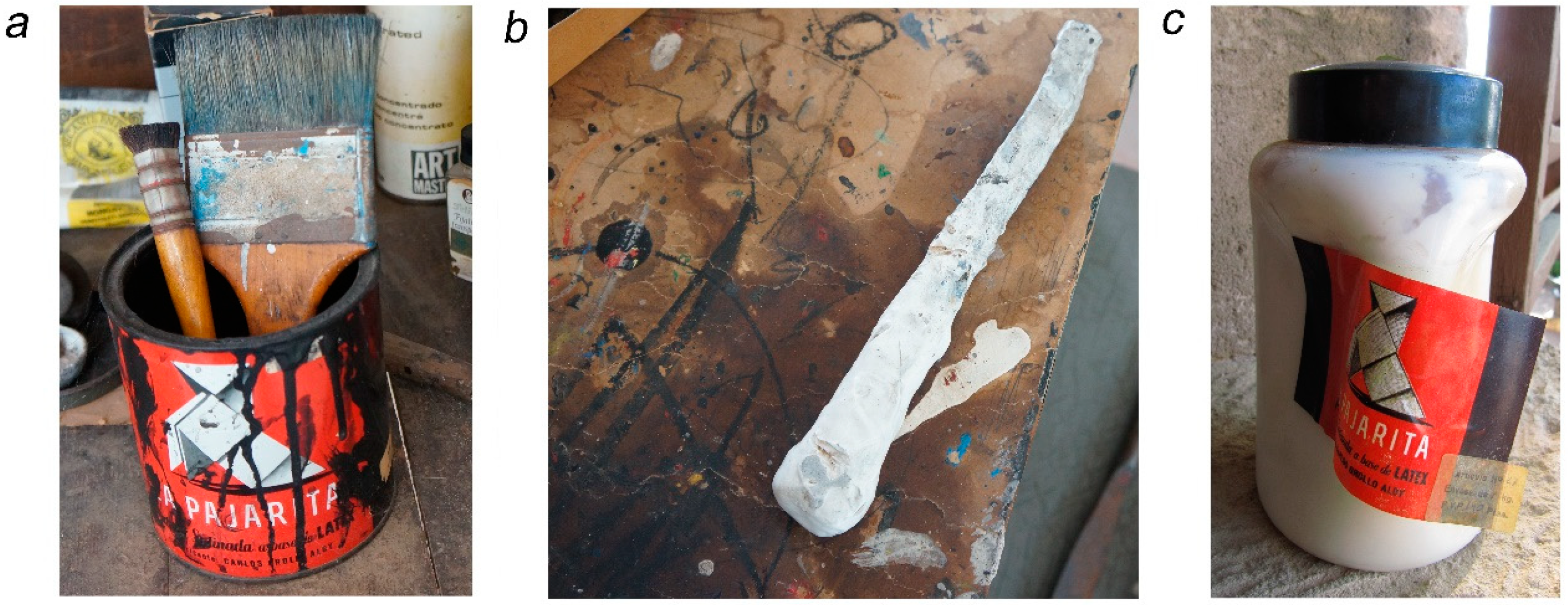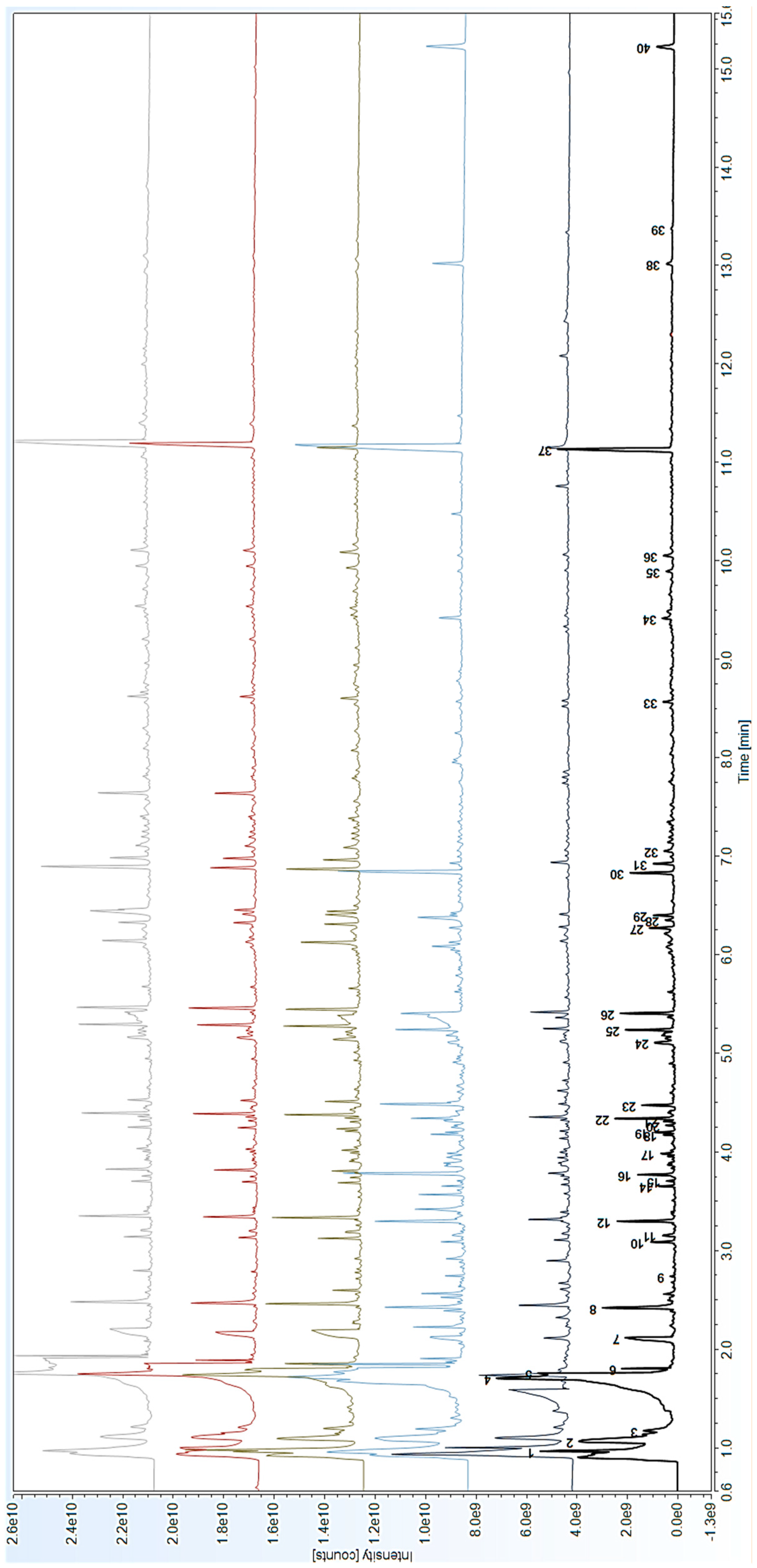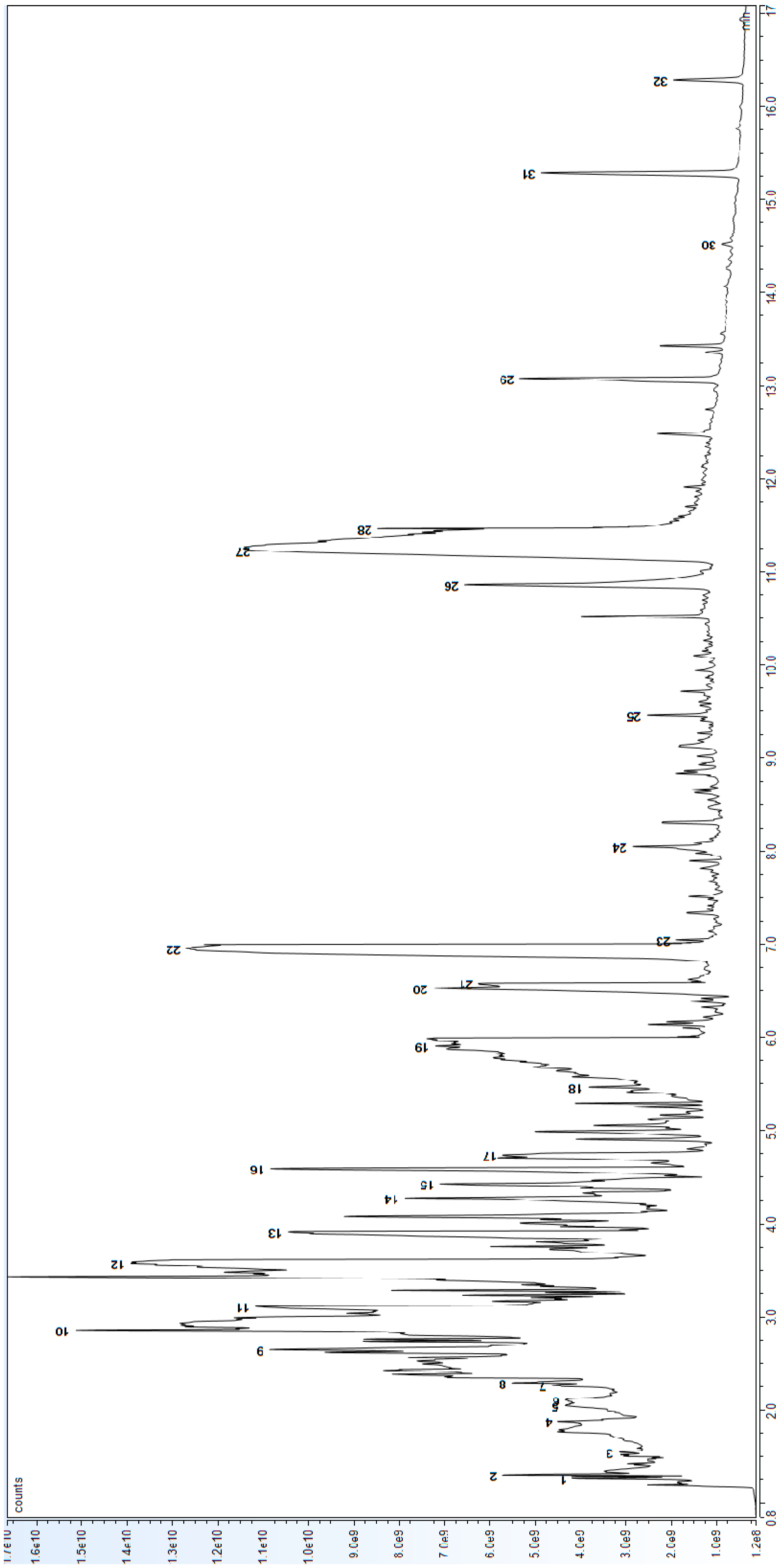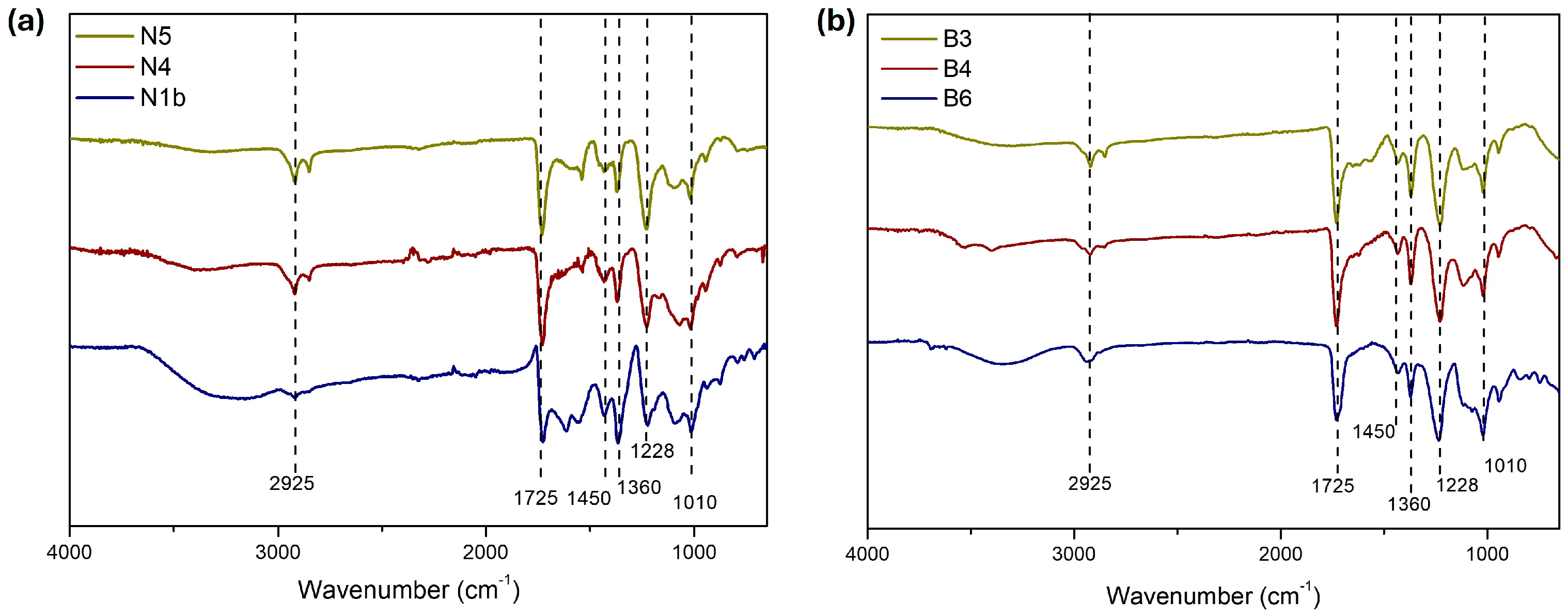Unveiling the Composition of La Pajarita PVAc-Based Paints in Joan Miró’s Studio and in Three Artworks from the 1970s
Abstract
1. Introduction
2. Materials and Methods
2.1. Samples from Studio Materials and Artworks
2.1.1. Black Paint Samples
2.1.2. White Paint Samples
2.2. Analytical Techniques
2.2.1. Scanning Electron Microscopy with Energy Dispersive X-Ray Analysis (SEM–EDX)
2.2.2. X-Ray Diffraction (XRD)
2.2.3. Fourier-Transform Infrared Spectroscopy (FTIR)
2.2.4. Pyrolysis Gas Chromatography–Mass Spectrometry (Py/GC–MS)
3. Results and Discussion
3.1. Identification of the Synthetic Binding Media
- −
- Phthalate-based compounds, such as dibutyl phthalate, butyl 2-ethylhexyl phthalate, bis(2-ethylhexyl) phthalate, and butyl dodecyl phthalate, added in the past as external plasticisers;
- −
- Benzoate esters used as coalescing agents, such as butyl benzoate and 2-ethyl-hexyl benzoate;
- −
- Antifoam agents, polydimethylsiloxane and silicon oils in particular.
- −
- External plasticisers (and one notices other types of phthalates from those highlighted earlier);
- −
- Antifoam agents (such as siloxanes);
- −
- Freeze–thaw agents (such as ethylene glycol);
- −
- pH buffers (such as ammonia acetate).
3.2. Pigments and Additives in Black Paint Samples
3.3. Pigments and Additives in White Paint Samples
4. Conclusions and Further Work
Author Contributions
Funding
Institutional Review Board Statement
Data Availability Statement
Acknowledgments
Conflicts of Interest
References
- Freixa, J. L’estudi per a Joan Miró a Mallorca: Assaig per a un futur millor. In Miro Fundació Pilar i Joan Miró a Mallorca; Lunwerg Editores: Barcelona, Spain, 2005; pp. 36–43. [Google Scholar]
- Bestard, B. Son Boter. In Miro Fundació Pilar i Joan Miró a Mallorca; Lunwerg Editores: Barcelona, Spain, 2005; pp. 44–49. [Google Scholar]
- Russell, J.E.; Singer, B.W.; Perry, J.J.; Bacon, A. Investigation of the materials found in the studio of Francis Bacon (1909–1992). Stud. Conserv. 2012, 57, 195–206. [Google Scholar] [CrossRef]
- Bustin, M. Towards Interpretation of Making, Meaning, and Change in British Twentieth Century Oil Paintings: The Relevance of an Artist’s Paint Archive. In Issues in Contemporary Oil Paint; van den Berg, K.J., Burnstock, A., de Keijzer, M., Krueger, J., Learner, T., de Tagle, A., Heydenreich, G., Eds.; Springer International Publishing: Cham, Switzerland, 2014; pp. 33–43. [Google Scholar]
- Izzo, F.C.; Zanin, C.; Van Keulen, H. From pigments to paints: Studying original materials from the atelier of the artist Mariano Fortuny y Madrazo. Int. J. Conserv. Sci. 2017, 8, 547–564. [Google Scholar]
- Caruso, F.; Mantellato, S.; Streeton, N.L.W.; Frøysaker, T. Unveiling Harriet Backer: ICP–OES study for the characterisation of the colour tubes from her original paint box. Herit. Sci. 2019, 7, 1–23. [Google Scholar] [CrossRef]
- Gil, M.; Costa, M.; Cardoso, A.; Valadas, S.; Helvaci, Y.; Bhattacharya, S.; Moita, P.; Candeias, A. On the Two Working Palettes of Almada Negreiros at DN Building in Lisbon (1939–1940): First Analytical Approach and Insight on the Use of Cd Based Pigments. Heritage 2021, 4, 4578–4595. [Google Scholar] [CrossRef]
- Rogala, D. Hans Hofmann’s Last Lesson: A Study of the Artist’s Materials in the Last Decade of His Career. In Issues in Contemporary Oil Paint; van den Berg, K.J., Burnstock, A., de Keijzer, M., Krueger, J., Learner, T., de Tagle, A., Heydenreich, G., Eds.; Springer International Publishing: Cham, Switzerland, 2014; pp. 127–148. [Google Scholar] [CrossRef]
- Sandu, I.C.A.; Sandbakken, E.G.; Ferrer, J.S.; Syversen, T.; Hull, A. The Art Historical Materials Collection at Munch: Colours, Brands, Labels. Int. J. Conserv. Sci. 2022, 13, 1653–1664. [Google Scholar]
- Dalecky, L.; Bonaduce, I.; Anheim, É.; Nasa, J.L.; L’Héronde, M.; Morel, C.; Catelli, E.; Prati, S.; Li, Z.; Beck, L.; et al. A typical postwar workshop: Insights into Simon Hantaï’s oil paint palette. J. Cult. Herit. 2024, 66, 511–522. [Google Scholar] [CrossRef]
- Gomez Lobon, M.; Ghirardello, M.; Juncosa Darder, E.; Palomino Cabello, C.; Bauza, M.; Cotte, M.; Burnstock, A.; Nevin, A.; Amato, S.R.; Izzo, F.C.; et al. A study of cadmium yellow paints from Joan Miró’s paintings and studio materials preserved at the Fundació Miró Mallorca. Herit. Sci. 2023, 11, 145. [Google Scholar] [CrossRef]
- Crook, J.; Learner, T. The Impact of Modern Paints; Tate Gallery Publishing: London, UK, 2000; 192p. [Google Scholar]
- Learner, T. Modern Paints Uncovered: Proceedings from the Modern Paints Uncovered Symposium; Getty Conservation Institute, Ed.; Getty Conservation Institute: Los Angeles, CA, USA, 2008. [Google Scholar]
- Smithen, P. The Development and Impact of Artists’ Acrylic Paint in the United Kingdom. Ph.D. Thesis, University of London, Courtauld Institute of Art, London, UK, 2022. [Google Scholar]
- Rowell, M. (Ed.) Joan Miró: Selected Writings and Interviews; Thames and Hudson: London, UK, 1987; The Documents of twentieth century art. [Google Scholar]
- Novak, M.; Ormsby, B. Poly(Vinyl Acetate) Paints: A Literature Review of Material Properties, Ageing Characteristics, and Conservation Challenges. Polymers 2023, 15, 4348. [Google Scholar] [CrossRef]
- Dupin, J.; Lelong-Mainaud, A. Miró: Catalogue Raisonné, Paintings, Volume IV: 1959–1968; Polígrafa/Lelong: Paris, France, 2002; 268p. [Google Scholar]
- Serrat, E.; Becerra, J.; Vila, A. The materials and techniques used by Joan Miró: A study of the historical sources. In ICOM-CC 20th Triennial Conference Preprints, Valencia, Spain, 18–22 September 2023; International Council of Museums: Paris, France, 2023. [Google Scholar]
- Chiantore, O.; Trossarelli, L.; Lazzari, M. Photooxidative degradation of acrylic and methacrylic polymers. Polymer 2000, 41, 1657–1668. [Google Scholar] [CrossRef]
- Bracci, S.; Melo, M.J. Correlating natural ageing and Xenon irradiation of Paraloid® B72 applied on stone. Polym. Degrad. Stab. 2003, 80, 533–541. [Google Scholar] [CrossRef]
- Ferreira, J.; Melo, M.; Ramos, A. Poly(vinyl acetate) paints in works of art: A photochemical approach. Part 1. Polym. Degrad. Stab. 2010, 95, 453–461. [Google Scholar] [CrossRef]
- Doménech-Carbó, M.T.; Silva, M.F.; Aura-Castro, E.; Fuster-López, L.; Kröner, S.; Martínez-Bazán, M.L.; Más-Barberá, X.; Mecklenburg, M.F.; Osete-Cortina, L.; Doménech, A.; et al. Study of behaviour on simulated daylight ageing of artists’ acrylic and poly(vinyl acetate) paint films. Anal. Bioanal. Chem. 2011, 399, 2921–2937. [Google Scholar] [CrossRef] [PubMed]
- Ferreira, J.L.; Ávila, M.J.; Melo, M.J.; Ramos, A.M. Early aqueous dispersion paints: Portuguese artists’ use of polyvinyl acetate, 1960s–1990s. Stud. Conserv. 2013, 58, 211–225. [Google Scholar] [CrossRef]
- Ferreira, J.L. ‘Eternity Is in Love with the Productions of Time’: Joaquim Rodrigo’s Classical Palette in a Vinyl Sinthetic Medium. In Modern Paints Uncovered: Proceedings from the Modern Paints Uncovered Symposium; Getty Conservation Institute: Los Angeles, CA, USA, 2008; pp. 43–52. [Google Scholar]
- Izzo, F.C.; Balliana, E.; Pinton, F.; Zendri, E. A preliminary study of the composition of commercial oil, acrylic and vinyl paints and their behaviour after accelerated ageing conditions. Conserv. Sci. Cult. Herit. 2014, 14, 353–369. [Google Scholar] [CrossRef]
- Gomez Lobon, M.; Juncosa Darder, E.; Palomino Cabello, C.; Bauza, M. Investigación de los pigmentos utilizados por Joan Miró durante su etapa artística en Mallorca [Investigation of the pigments used by Joan Miró during his artistic period in Mallorca]. In 24a Jornada de Conservación de Arte Contemporáneo; MNCARS: Madrid, Spain, 2023; pp. 13–26. [Google Scholar]
- Pagnin, L.; Zendri, E.; Izzo, F.C. How Can Ozone and Relative Humidity Affect Artists’ Alkyd Paints? A FT-IR and Py-GC/MS Systematic Study. Polymers 2022, 14, 1831. [Google Scholar] [CrossRef]
- Silva, M.F.; Doménech-Carbó, M.T.; Fuster-López, L.; Mecklenburg, M.F.; Martin-Rey, S. Identification of additives in poly(vinylacetate) artist’s paints using PY-GC-MS. Anal. Bioanal. Chem. 2010, 397, 357–367. [Google Scholar] [CrossRef]
- Ploeger, R.; Scalarone, D.; Chiantore, O. The characterization of commercial artists’ alkyd paints. J. Cult. Herit. 2008, 9, 412–419. [Google Scholar] [CrossRef]
- Doménech-Carbó, M.; Bitossi, G.; Oc, L.; Yusà-Marco, D. Study of ageing of ketone resins used as picture varnishes by pyrolysis–silylation–gas chromatography–mass spectrometry. J. Anal. Appl. Pyrolysis 2009, 85, 470–479. [Google Scholar] [CrossRef]
- La Nasa, J.; Degano, I.; Modugno, F.; Colombini, M. Alkyd paints in art: Characterization using integrated mass spectrometry. Anal. Chim. Acta 2013, 797, 64–80. [Google Scholar] [CrossRef]
- Wei, S.; Pintus, V.; Schreiner, M. Photochemical degradation study of polyvinyl acetate paints used in artworks by Py–GC/MS. J. Anal. Appl. Pyrolysis 2012, 97, 158–163. [Google Scholar] [CrossRef]
- Silva, M.F.; Doménech-Carbó, M.T.; Osete-Cortina, L. Characterization of additives of PVAc and acrylic waterborne dispersions and paints by analytical pyrolysis–GC–MS and pyrolysis–silylation–GC–MS. J. Anal. Appl. Pyrolysis 2015, 113, 606–620. [Google Scholar] [CrossRef]
- Pintus, V.; Viana, C.; Angelin, E.M.; De Sá, S.F.; Wienland, K.; Sterflinger, K.; Ferreira, J.L. Applicability of single-shot and double-shot Py-GC/MS for the detection of components in vinyl acetate-based emulsions used in modern-contemporary art. J. Anal. Appl. Pyrolysis 2022, 168, 105782. [Google Scholar] [CrossRef]
- Van Keulen, H.; Schilling, M. AMDIS & EXCEL: A Powerful Combination for Evaluating THM-Py-GC/MS Results from European Lacquers. Stud Conserv. 2019, 64 (Suppl. S1), S74–S80. [Google Scholar] [CrossRef]
- Pereira, A.I. The Perfect Paint in Modern Art Conservation: A Comparative Study of 21st Century Vinyl Emulsions; Universidade Nova de Lisboa: Lisboa, Portugal, 2015. [Google Scholar]
- Mayer, R. The Artist’s Handbook of Materials and Techniques, 5th ed.; Revised and Expanded by Steven Sheehan; Faber and Faber: London, UK, 1991. [Google Scholar]
- França De Sá, S.; Viana, C.; Ferreira, J.L. Tracing Poly(Vinyl Acetate) Emulsions by Infrared and Raman Spectroscopies: Identification of Spectral Markers. Polymers 2021, 13, 3609. [Google Scholar] [CrossRef]
- Dredge, P.; Carter, A.; Osmond, G. Sidney Nolan: The Artist’s Materials; The Getty Conservation Institute: Los Angeles, CA, USA, 2020; The artist’s materials. [Google Scholar]
- Price, B.A.; Pretzel, B.; Quillen Lomax, S. Infrared and Raman Users Group Spectral Database. 2009. Available online: www.irug.org (accessed on 20 October 2024).
- Dupin, J.; Lelong-Mainaud, A. Miró: Catalogue Raisonné. Paintings. Volume VI: 1976–1981; Polígrafa/Lelong: Paris, France, 2004. [Google Scholar]







| No. | Image | Object | SEM–EDX | XRD | FTIR (ATR) | PY–GC–MS (Main Compounds Detected) | Interpretation | |
|---|---|---|---|---|---|---|---|---|
| BLACK PAINT SAMPLES | N1b |  | Can of black paint, La Pajarita, Taller Sert | C, O, S, Ba (Na, Mg, Si, K, Al, Ca, Cl) | BaSO4 | PVAc BaSO4 CaMg(CO3)2 | acetic acid, acetone, 1,3-cyclopentadiene, benzene (and benzene derivatives), toluene, indane, indene, methylindenes, naphthalene; dibutyl phthalate, butyl 2-ethylhexyl phthalate, bis(2-ethylhexyl) phthalate and butyl dodecyl phthalate; butyl benzoate and 2-ethyl-hexyl benzoate | Pigment: carbon black Fillers/extenders: barium sulphate, dolomite Binder: polyvinyl acetate-based paint with external plasticisers (dibutyl phthalate, butyl 2-ethylhexyl phthalate, bis(2-ethylhexyl) phthalate and butyl dodecyl phthalate), coalescing agents (butyl benzoate and 2-ethyl-hexyl benzoate) and other additives |
| N4 |  | Untitled (FPJM-00106)1973 Catalogued as acrylic and charcoal on canvas 216 × 173.8 cm | C, O, S, Ba, Zn (Mg, Si, K, Al, Ca) | BaSO4 ZnO | PVAc BaSO4 CaMg(CO3)2 | acetic acid, acetone, 1,3-cyclopentadiene, benzene (and benzene derivatives), toluene, indane, indene, methylindenes, naphthalene; dibutyl phthalate, butyl 2-ethylhexyl phthalate, bis(2-ethylhexyl) phthalate and butyl dodecyl phthalate; butyl benzoate and 2-ethyl-hexyl benzoate | Pigment: carbon black, zinc oxide possibly corresponds to priming layer Fillers/extenders: barium sulphate, dolomite Binder: polyvinyl acetate-based paint with external plasticisers (dibutyl phthalate, butyl 2-ethylhexyl phthalate, bis(2-ethylhexyl) phthalate and butyl dodecyl phthalate), coalescing agents (butyl benzoate and 2-ethyl-hexyl benzoate) and other additives | |
| N5 |  | Untitled (FPJM-00108) 1973 Catalogued as acrylic and charcoal on canvas 174 × 293 cm | C, O, S, Ba (Na, Mg, Si, K, Al, Ca) | BaSO4 | PVAc BaSO4 CaMg(CO3)2 | acetic acid, acetone, 1,3-cyclopentadiene, benzene (and benzene derivatives), toluene, indane, indene, methylindenes, naphthalene; dibutyl phthalate, butyl 2-ethylhexyl phthalate, bis(2-ethylhexyl) phthalate and butyl dodecyl phthalate; butyl benzoate and 2-ethyl-hexyl benzoate | Pigment: carbon black Extenders: barium sulphate, dolomite Binder: polyvinyl acetate-based paint with external plasticisers (dibutyl phthalate, butyl 2-ethylhexyl phthalate, bis(2-ethylhexyl) phthalate and butyl dodecyl phthalate), coalescing agents (butyl benzoate and 2-ethyl-hexyl benzoate) and other additives | |
| WHITE PAINT SAMPLES | B3 |  | Stick coated with white paint, used to mix paint Taller Sert | C, O, Ti, Na, Al, Si (S, Ca) | TiO2 (mainly rutile) | PVAc TiO2 | acetic acid, acetone, 1,3-cyclopentadiene, benzene (and benzene derivatives), toluene, indane, indene, methylindenes, naphthalene; dibutyl phthalate, butyl 2-ethylhexyl phthalate, bis(2-ethylhexyl) phthalate and butyl dodecyl phthalate; butyl benzoate and 2-ethyl-hexyl benzoate | Pigment: titanium white (titanium dioxide) Extenders: possibly kaolin (hydrated aluminosilicate) Binder: polyvinyl acetate-based paint with external plasticisers (dibutyl phthalate, butyl 2-ethylhexyl phthalate, bis(2-ethylhexyl) phthalate and butyl dodecyl phthalate), coalescing agents (butyl benzoate and 2-ethyl-hexyl benzoate) and other additives |
| B4 |  | Untitled (FPJM-00135), 1977 Catalogued as oil and acrylic on plywood 122 × 89 cm | C, O, Ti, Na, Al, Si (S, Ca) | TiO2 (mainly rutile) | PVAc TiO2 | acetic acid, acetone, 1,3-cyclopentadiene, benzene (and benzene derivatives), toluene, indane, indene, methylindenes, naphthalene; dibutyl phthalate, butyl 2-ethylhexyl phthalate, bis(2-ethylhexyl) phthalate and butyl dodecyl phthalate; butyl benzoate and 2-ethyl-hexyl benzoate | Pigment: titanium white (titanium dioxide) Extenders: possibly kaolin (hydrated aluminosilicate) Binder: polyvinyl acetate-based paint with external plasticisers (dibutyl phthalate, butyl 2-ethylhexyl phthalate, bis(2-ethylhexyl) phthalate and butyl dodecyl phthalate), coalescing agents (butyl benzoate and 2-ethyl-hexyl benzoate) and other additives | |
| B6 |  | Bottle with white paint, La Pajarita, Son Boter | C and O only | None (amorphous) | PVAc | acetic acid, acetone, 1,3-cyclopentadiene, benzene (and benzene derivatives), toluene, indane, indene, methylindenes, naphthalene; dibutyl phthalate, butyl 2-ethylhexyl phthalate, bis(2-ethylhexyl) phthalate and butyl dodecyl phthalate; butyl benzoate and 2-ethyl-hexyl benzoate; polydimethylsiloxane and silicon oils, siloxanes; ethylene glycol; ammonia acetate | Pigment: none detected Binder: polyvinyl acetate-based paint with external plasticisers (dibutyl phthalate, butyl 2-ethylhexyl phthalate, bis(2-ethylhexyl) phthalate and butyl dodecyl phthalate), coalescing agents (butyl benzoate and 2-ethyl-hexyl benzoate), antifoam agents (siloxanes), freeze–thaw agents (ethylene glycol) and pH buffers (ammonia acetate) |
| Peak Number | RT (min) | Identified Compounds |
|---|---|---|
| 1 | 0.969 | 2-Butene |
| 2 | 1.065 | Acetone |
| 3 | 1.17 | 1,3-Cyclopentadiene |
| 4 | 1.704 | Benzene |
| 5 | 1.755 | Acetic acid |
| 6 | 1.779 | Butyl alcohol |
| 7 | 2.075 | Acetic anhydride |
| 8 | 2.456 | Toluene |
| 9 | 2.738 | Acetic acid, butyl ester |
| 10 | 3.085 | Ethylbenzene |
| 11 | 3.122 | p-Dimethylbenzene |
| 12 | 3.33 | Styrene |
| 13 | 3.544 | Benzene, (1-methylethyl)- |
| 14 | 3.653 | Benzene, 2-propenyl- |
| 15 | 3.704 | Benzene, propyl- |
| 16 | 3.768 | Benzaldehyde |
| 17 | 3.99 | Benzene, 2-propenyl- |
| 18 | 4.173 | 1-Hexanol, 2-ethyl- |
| 19 | 4.197 | Benzene, 2-propenyl- |
| 20 | 4.268 | Indane |
| 21 | 4.309 | Benzene, 3-butenyl- |
| 22 | 4.336 | Indene |
| 23 | 4.462 | Acetophenone |
| 24 | 5.105 | 1,2-Dihydronaphthalene |
| 25 | 5.234 | 1,4-Dihydronaphthalene |
| 26 | 5.401 | Naphthalene |
| 27 | 6.268 | α-Methylnaphthalene |
| 28 | 6.350 | Phthalic anhydride |
| 29 | 6.398 | β-Methylnaphthalene |
| 30 | 6.829 | Benzoic acid, butyl ester |
| 31 | 6.921 | Biphenyl |
| 32 | 7.051 | Naphthalene, 1-(2-propenyl)- |
| 33 | 8.564 | Fluorene |
| 34 | 9.414 | Benzoic acid, 2-ethylhexyl ester |
| 35 | 9.890 | Anthracene, 9,10-dihydro- |
| 36 | 10.050 | Anthracene |
| 37 | 11.132 | Dibutyl phthalate |
| 38 | 13.019 | Butyl 2-ethylhexyl phthalate |
| 39 | 13.373 | Phthalic acid, butyl dodecyl ester |
| 40 | 15.220 | Bis(2-ethylhexyl) phthalate |
| Peak Number | RT (min) | Identified Compounds |
|---|---|---|
| 1 | 1.262 | Propene |
| 2 | 1.299 | 1-Butene |
| 3 | 1.547 | 1,3-Cyclopentadiene |
| 4 | 1.877 | Acetic acid |
| 5 | 2.047 | Benzene |
| 6 | 2.105 | 2-Butenal, (E)- |
| 7 | 2.265 | Ammonium acetate |
| 8 | 2.289 | n-Butyl formate |
| 9 | 2.646 | Benzyl ether |
| 10 | 2.857 | 1,3,5-Heptatriene, (E,E)- |
| 11 | 3.112 | Ethylene glycol ethyl ether |
| 12 | 3.575 | 2,4-Hexadienal, (E,E)- |
| 13 | 3.911 | Benzaldehyde |
| 14 | 4.275 | Indane |
| 15 | 4.428 | Benzyl alcohol |
| 16 | 4.592 | 1,3-Dihydro isobenzofuran |
| 17 | 4.738 | Methyl benzoate |
| 18 | 5.462 | Naphthalene |
| 19 | 5.904 | Benzoic acid |
| 20 | 6.527 | Phthalic acid |
| 21 | 6.578 | Phthalic anhydride |
| 22 | 6.952 | Butyl benzoate |
| 23 | 7.044 | Biphenyl |
| 24 | 8.047 | 2-Naphthalenecarboxaldehyde |
| 25 | 9.459 | Ethylhexyl benzoate |
| 26 | 10.86 | Diisobutyl phthalate |
| 27 | 11.217 | Dibutyl phthalate |
| 28 | 11.462 | Butyl octyl phthalate |
| 29 | 13.077 | Phthalic acid, butyl 2-ethylhexyl ester |
| 30 | 14.523 | Butyl isodecyl phthalate |
| 31 | 15.285 | Bis(2-ethylhexyl) phthalate |
| 32 | 16.281 | Phthalic acid, dinonyl ester |
Disclaimer/Publisher’s Note: The statements, opinions and data contained in all publications are solely those of the individual author(s) and contributor(s) and not of MDPI and/or the editor(s). MDPI and/or the editor(s) disclaim responsibility for any injury to people or property resulting from any ideas, methods, instructions or products referred to in the content. |
© 2024 by the authors. Licensee MDPI, Basel, Switzerland. This article is an open access article distributed under the terms and conditions of the Creative Commons Attribution (CC BY) license (https://creativecommons.org/licenses/by/4.0/).
Share and Cite
Gomez Lobon, M.; Juncosa Darder, E.; Palomino Cabello, C.; Bauza, M.; Izzo, F.C. Unveiling the Composition of La Pajarita PVAc-Based Paints in Joan Miró’s Studio and in Three Artworks from the 1970s. Polymers 2024, 16, 3146. https://doi.org/10.3390/polym16223146
Gomez Lobon M, Juncosa Darder E, Palomino Cabello C, Bauza M, Izzo FC. Unveiling the Composition of La Pajarita PVAc-Based Paints in Joan Miró’s Studio and in Three Artworks from the 1970s. Polymers. 2024; 16(22):3146. https://doi.org/10.3390/polym16223146
Chicago/Turabian StyleGomez Lobon, Mar, Enric Juncosa Darder, Carlos Palomino Cabello, Marta Bauza, and Francesca Caterina Izzo. 2024. "Unveiling the Composition of La Pajarita PVAc-Based Paints in Joan Miró’s Studio and in Three Artworks from the 1970s" Polymers 16, no. 22: 3146. https://doi.org/10.3390/polym16223146
APA StyleGomez Lobon, M., Juncosa Darder, E., Palomino Cabello, C., Bauza, M., & Izzo, F. C. (2024). Unveiling the Composition of La Pajarita PVAc-Based Paints in Joan Miró’s Studio and in Three Artworks from the 1970s. Polymers, 16(22), 3146. https://doi.org/10.3390/polym16223146







